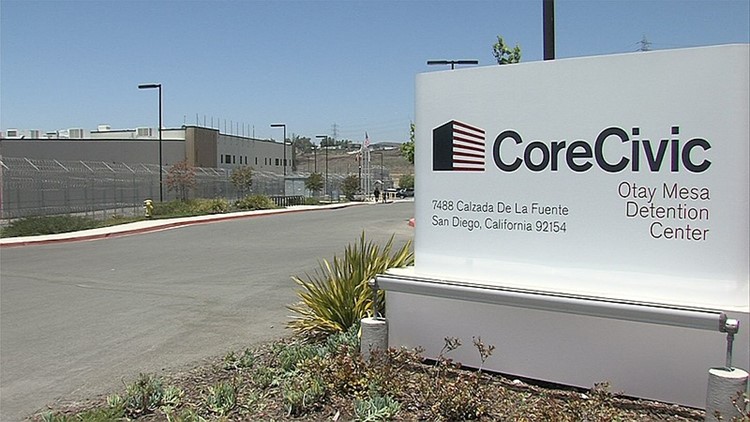SAN DIEGO COUNTY, Calif. — A San Diego detention center that houses U.S. Immigration and Customs Enforcement detainees saw COVID-19 cases surge last week, reporting the third highest number of active cases among ICE detainees of any of the federal agency's more than 130 detention centers.
On Jan. 10, the Otay Mesa Detention Center reported having 91 people in isolation or being monitored with confirmed cases, ICE reported in online data. That number was an all time high for the San Diego facility and was surpassed only by facilities in Arizona and Texas, similarly situated near the U.S.-Mexico border.
The infections account for about 10% of ICE detainees at the facility based on population numbers that an attorney with American Civil Liberties Union of San Diego and Imperial Counties said the agency provided at the beginning of this month.
The ACLU receives data regularly from the ICE facility, located in southern San Diego County just three miles from the U.S.-Mexico border, as part of an agreement in a lawsuit over COVID-19 protections at the facility.
The case counts fluctuate daily. The 91 reported active cases among detainees as of Jan. 10 fell to 52 by Sunday, according to ICE’s website.
However, the outbreak still represents the highest active case count among ICE detainees in the facility since the pandemic began, according to case counts tracked by UCLA. It comes amid a recent increase in immigrant arrivals at the southern border while cases of the omicron variant skyrocket across the United States. It is one of several ICE facilities situated along the U.S.-Mexico border that is experiencing high case counts.
An attorney for the ACLU said there are more than 500 medically vulnerable detainees housed at Otay Mesa, whose population has doubled in less than a year. Many of those detainees could be released under an existing court order, he said.
A lack of clear data around who is tested and vaccinated within the facilities raises questions about how protected detainees are from the outbreak, experts said.
“We're concerned about the health and safety of the people inside and we're concerned about the health and safety of people in the surrounding communities,” said Joshua Manson, communications manager for UCLA School of Law’s COVID Behind Bars Data Project.
“We know that outbreaks don't stay behind prison or detention center walls.”
The border facility, which houses migrants awaiting court dates or deportation and federal inmates under U.S. Marshals Service custody awaiting trials or sentencing, is owned and operated by CoreCivic, a private detention and corrections management company that operates six facilities in California and more than 100 across the United States.
There are 17 active cases among its employees at Otay Mesa as of Jan. 12, according to data posted on the company’s website.
A spokesperson for ICE declined to comment on questions from inewsource about the outbreak but said the agency “remains committed to applying CDC guidance and providing vaccine education that ensures those in our care and custody can make an informed choice during this global pandemic.”
The U.S. Marshals Service did not answer specific questions about the outbreak but said through a spokesperson that facilities that house federal inmates, including the Otay Mesa Detention Center, “are responsible for the medical care that prisoners receive.”
“All training protocols, quarantine decisions or policy adjustments are made at the facility level,” Lynzey Donahue, spokesperson for the U.S. Marshals said in an email.
COVID-19 cases surge
While active cases started to decline at Otay Mesa toward the end of last week, the outbreak represents the facility’s largest since the pandemic began and comes while its detainee population is more than twice what it was less a year ago.
More than 750 people have tested positive for COVID-19 while at the facility, as of Jan. 17. One ICE detainee died from the virus in May 2020.
At the end of December, ICE reported six COVID-19 cases among the facility’s detainees. By the next week, that number was up to 36.
Less than a week after that, the agency reported 91 active cases among detainees – the highest active case count yet, according to the UCLA School of Law’s COVID Behind Bars Data Project, which has collected data reported by corrections and detention agencies over the course of the pandemic.
The facility’s previous outbreaks were less than half the size of the most recent one. The second highest active case count at the facility was reported in July 2021 with 44 cases, according to UCLA data.
Ryan Gustin, a spokesperson for CoreCivic, said “many of the current active cases” at Otay Mesa include migrants who entered the facility already infected with the virus.
“With the recent increase of immigrants entering the United States along our southern border, we have seen a similar increase in the number of detainees that are arriving to our facilities already positive for COVID-19,” Gustin said in an email.
Border Patrol encounters in the San Diego Sector in October were double what they were the year before, according to the latest available online data.
Monthly encounters increased from September to October by 13%, then decreased the following month by 6% for a total of 13,416 encounters in November 2021.
But quarantines resulting from the latest outbreak have affected long-term detainees as well.
Lilia Rodriguez, an immigration attorney in San Diego, said her client, a 34-year-old man from Nicaragua who’s been detained at Otay Mesa for nearly six months, was forced to miss a special bond hearing that could have allowed him to be released from detention at the facility.
Rodriguez said not all housing units have the equipment needed to attend court appearances or meet with attorneys virtually. That means court proceedings are often delayed for those quarantined in units without the equipment.
“It does really, really hinder how they can find ways to get out of detention and proceed with their cases, so it's just frustrating for them and for us,” Rodriguez said.
Rodriguez said the quarantines can also be extended multiple times, further delaying her clients’ proceedings.
CoreCivic did not answer specific questions about how many housing units or detainees at the facility are currently under quarantine. CoreCivic and ICE officials said the facility tests new detainees and inmates upon arrival and houses them separately from the general population for two weeks.
The number of ICE detainees at Otay Mesa has fluctuated over the course of the pandemic, but is now up to 810 as of early January, according to data from the ACLU. Nearly a year prior, in February 2021, that number was down to 332.
ICE declined to provide information about the number of detainees currently at the facility due to “security concerns.” However, ICE provides population numbers and other data regularly to the ACLU as part of an agreement in a class action lawsuit over COVID-19 protections at the facility and the Imperial Regional Detention Facility.
It’s concerning to Bardis Vakili, senior staff attorney at the ACLU of San Diego and Imperial Counties, that the detainee population size has swelled as much as it has, particularly because more than two-thirds of that population are medically vulnerable.
In the pandemic’s first year, a U.S. District Court judge ordered ICE to identify and consider releasing detainees who were medically vulnerable to COVID-19. That order is ongoing and applies to ICE facilities across the country.
Now, though, Vakili said there are about 540 medically vulnerable detainees at Otay Mesa who meet the standards set in that case, Fraihat, et al. v. U.S. Immigration and Customs Enforcement, that have not been released yet.
“That's a lot of risk you're imposing on several hundred people who are at the mercy of the people who are taking them into custody,” Vakili said.
That number comes from the data reports the ACLU receives from the facility. CoreCivic’s medical staff confirms the conditions that make detainees vulnerable to COVID-19 as they arrive at the facility or while they are detained.
ICE did not answer questions about those detainees or why they had not been released.
Manson, with the UCLA COVID Behind Bars Data Project, said that after two years of collecting data on COVID-19 testing and cases at federal, state and local incarceration facilities, he sees the way to prevent large outbreaks.
“The best measure that can be taken to address COVID-19 in congregate settings, including in prisons and detention centers, is decarceration and decreasing population density,” Manson said.
Vaccination and the risk of community spread
Murky information about vaccinations among ICE detainees raises questions about who is protected from the virus.
ICE’s national vaccination campaign was criticized for being inconsistent across facilities and not providing a clear picture of vaccination rates and accessibility for detainees.
A report published in September from Homeland Security’s inspector general found that Otay Mesa complied with standards for classifying detainee risk levels and provided adequate medical care. However, it also found that the facility “compromised the health, safety and rights of detainees” by failing to enforce COVID-19 precautions like mask-wearing and social distancing.
In response a top ICE official reported that medical staff at Otay Mesa had administered more than 750 doses of the vaccines to detainees by mid-August.
ICE has since then declined to provide inewsource with an updated number of vaccine administrations at Otay Mesa. A spokesperson for the agency said across its facilities, “48,246 noncitizens elected to receive COVID-19 vaccinations” as of Jan. 5. The agency said it began providing detainees with booster shots in November.
Vakili, the ACLU attorney, said there’s been some confusion among detainees about vaccinations. He said some have called his team asking basic questions about boosters and the types of vaccines offered.
“This is a population that may not have a lot of access to information prior to getting there. And so it's really important to educate folks about vaccines so they can make informed health decisions,” Vakili said.
Manson shares those concerns.
“It's not clear that people in its custody are being given proper educational materials and information in the right language about the vaccination, and we think that that's really paramount for the health and safety of people inside the facilities and in surrounding communities.”
Gustin said CoreCivic detainees are provided information about vaccines during intake and with digital tablets that have information in more than a dozen languages. The company said it has held numerous vaccination events where detainees and employees can get vaccinated.
All of the company’s employees at Otay Mesa are either partially or fully vaccinated, Gustin said.
The agency does not post vaccinations rates for its facilities publicly, and turnover among detainees at Otay Mesa complicates getting a clear picture of how much of the population is vaccinated at any point in time.
In the 2021 fiscal year, the average length of stay in ICE custody was 37 days, according to the agency. But while some detainees are there for months, others filter in and out of the facility in a matter of days, keeping the average length of stay low, said Vakili, the ACLU attorney.
“We have been in contact with people that have been there for the entirety of the pandemic,” Vakili said. “The need to vaccinate them, the need to ensure they have access to boosters to continue to protect them is really critical.”



